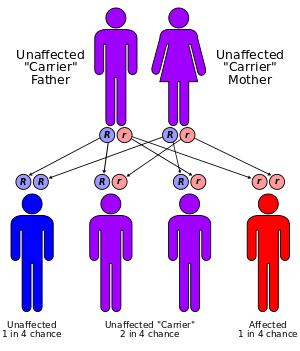Dubin–Johnson syndrome
| Dubin–Johnson syndrome | |
|---|---|
 | |
| Bilirubin | |
| Classification and external resources | |
| Specialty | endocrinology |
| ICD-10 | E80.6 |
| ICD-9-CM | 277.4 |
| OMIM | 237500 |
| DiseasesDB | 3982 |
| MedlinePlus | 000242 |
| eMedicine | med/588 |
| Patient UK | Dubin–Johnson syndrome |
| MeSH | D007566 |
Dubin–Johnson syndrome (DJS) is a rare, autosomal recessive, benign disorder that causes an isolated increase of conjugated bilirubin in the serum. Classically, the condition causes a black liver due to the deposition of a pigment similar to melanin.[1] This condition is associated with a defect in the ability of hepatocytes to secrete conjugated bilirubin into the bile, and is similar to Rotor syndrome. It is usually asymptomatic, but may be diagnosed in early infancy based on laboratory tests. No treatment is usually needed.[1]
Pathophysiology
The conjugated hyperbilirubinemia is a result of defective endogenous and exogenous transfer of anionic conjugates from hepatocytes into the bile.[2] Impaired biliary excretion of bilirubin glucuronides is due to a mutation in the canalicular multiple drug-resistance protein 2 (MRP2). A darkly pigmented liver is due to polymerized epinephrine metabolites, not bilirubin.[3]

DJS is due to a defect in the multiple drug-resistance protein 2 gene (ABCC2), located on chromosome 10.[1] It is an autosomal recessive disease and is likely due to a loss of function mutation, since the mutation affects the cytoplasmic/binding domain.
Diagnosis
A hallmark of DJS is the unusual ratio between the byproducts of heme biosynthesis:
- Unaffected subjects have a coproporphyrin III to coproporphyrin I ratio around 3–4:1.
- In patients with DJS, this ratio is inverted, with coproporphyrin I being 3–4 times higher than coproporphyrin III. Analysis of urine porphyrins shows a normal level of coproporphyrin, but the I isomer accounts for 80% of the total (normally 25%).
In post mortem autopsy, the liver will have a dark pink or black appearance due to pigment accumulation.
Plentiful canalicular multiple drug-resistant protein causes bilirubin transfer to bile canaliculi. An isoform of this protein is localized to the apical hepatocyte membrane, allowing transport of glucuronide and glutathione conjugates back into the blood. High levels of gamma-glutamyl transferase (GGT) help in diagnosing pathologies involving biliary obstruction.
Differentiation from Rotor Syndrome
Dubin–Johnson syndrome is similar to Rotor syndrome, but can be differentiated by:
| Rotor syndrome | Dubin–Johnson syndrome | |
| Appearance of liver | normal histology and appearance | liver has black pigmentation |
| Gallbladder visualization | gallbladder can be visualized by oral cholecystogram | gallbladder cannot be visualized |
| Total urine coproporphyrin content | high with <70% being isomer 1 | normal with >80% being isomer 1 (normal urine contains more of isomer 3 than isomer 1) |
Prognosis
Prognosis is good, and treatment of this syndrome is usually unnecessary. Most patients are asymptomatic and have normal lifespans.[2] Some neonates present with cholestasis.[2] Hormonal contraceptives and pregnancy may lead to overt jaundice and icterus (yellowing of the eyes and skin).
History
Dubin–Johnson syndrome was first described in 1954 by two men — Dr. Frank Johnson, a military physician and researcher at the Veterans Administration and Armed Forces Institute of Pathology in Washington, DC, and Dr. Isadore Dubin, a Canadian pathologist then working alongside him.[4] Dr. Johnson had studied medicine at Howard University College of Medicine and faced substantial discrimination in his medical career, being turned away from active duty during the Battle of the Bulge, despite being a first lieutenant and trained physician.[5] Later, during his internship, he was required to sleep in a tuberculosis sanitarium, as the hospital would not allow African-American physicians to live in the same residencies as white physicians, and he was prevented from rotating on several services, including general surgery.[5] These experiences, coupled with his inherent interest in chemistry, compelled him to pursue pathology, where he ultimately met Dr. Dubin and described this syndrome for the first time.
See also
References
- 1 2 3 Strassburg CP. "Hyperbilirubinemia syndromes (Gilbert-Meulengracht, Crigler-Najjar, Dubin-Johnson, and Rotor syndrome)". Best Practice & Research: Clinical Gastroenterology. 24 (5): 555–571. doi:10.1016/j.bpg.2010.07.007. PMID 20955959.
- 1 2 3 Suzanne M Carter, MS Dubin–Johnson Syndrome at eMedicine
- ↑ Kumar, Vinay (2007). Robbins Basic Pathology. Elsevier. p. 639.
- ↑ Dubin, IN; Johnson, F (September 1954). "Chronic idiopathic jaundice with unidentified pigment in liver cells; a new clinicopathologic entity with a report of 12 cases". Medicine (Baltimore). 33 (3): 155–198. doi:10.1097/00005792-195409000-00001. PMID 13193360.
- 1 2 Kennedy, Charles Stuart (1992). Dr. Frank B. Johnson Oral History Interview. Armed Forces Institute of Pathology Oral History Program. Archived by the Internet Archive, retrieved March 24, 2016.
External links
- Dubin-Johnson syndrome at New York Times
- Dubin-Johnson syndrome at ght.nlm.nig.gov
- Dubin-Johnson syndrome at Medline Plus encyclopedia
- Dubin–Johnson syndrome at NIH's Office of Rare Diseases